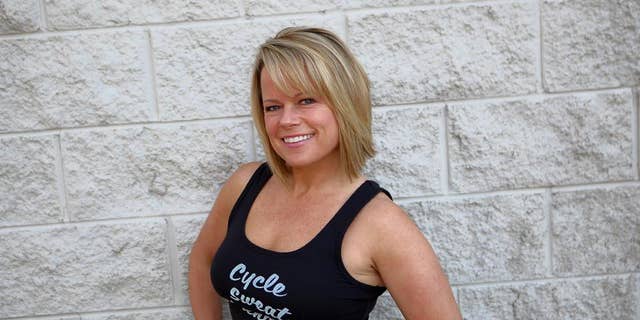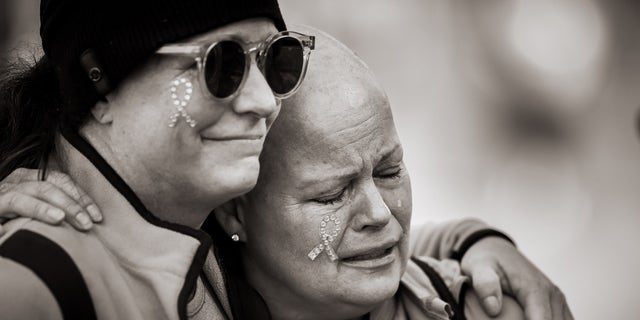Ohio woman pushes past breast cancer, won’t let diagnosis slow her down
There’s plenty of evidence that exercise can help prevent cancer — but what about exercising after a diagnosis?
Is it safe for cancer patients to engage in regular physical activity?
Not only is it safe, it’s beneficial. Exercise can alleviate the side effects of treatment, boost energy levels and improve quality of life — and could even help keep cancer from returning, according to the American Cancer Society.
MILITARY PILOTS AND GROUND CREWS SHOWING HIGH RATES OF CANCER, PENTAGON STUDY REVEALS
Erin Gratsch, a 51-year-old mother and fitness instructor who lives in Loveland, Ohio, a suburb of Cincinnati, had been an avid runner for 16 years when she was first diagnosed with breast cancer in 2016.
Over the course of her seven-year journey — through multiple surgeries, chemotherapy and radiation, setbacks and triumphs — exercise was one of her saving graces.
Recently, Gratsch ran 13.1 miles in the Heart Mini-Marathon in downtown Cincinnati, one of her favorite races. The next day, she had radiation treatment — which she’s currently doing five days a week.
‘I won’t let cancer slow me down’
Gratsch has completed a total of 54 marathons in the 22 years she’s been running — along with numerous miles logged in shorter races and training runs.
Just before Gratsch’s breast cancer diagnosis, she ran the Boston Marathon and the Flying Pig Marathon in Cincinnati.
“I was 45 years old, in the best shape of my life and had no family history of breast cancer,” she told Fox News Digital in an interview.
She also did not have the genetic mutation that increases the risk of the disease.

While doing some errands one day, Gratsch came across a mobile mammography unit.
On a whim, she went inside.
“I had no symptoms and no reason to worry — but I just felt compelled to get tested,” she said.
“If you have to get breast cancer, it’s the best kind you can get.”
Days later, she was diagnosed with ductal carcinoma, a non-invasive breast cancer in the milk ducts.
“If you have to get breast cancer, it’s the best kind you can get,” she said.
After a single mastectomy, Gratsch thought she was in the clear, and focused her efforts on raising awareness of early detection as the best means of breast cancer prevention.
FDA ISSUES NEW MAMMOGRAM REGULATIONS AIMED AT FURTHER BREAST CANCER PREVENTION
But then in July 2022, she found a lump in her breast. The cancer had returned — but this time it was HER2-positive, a more aggressive form.
Gratsch faced a more daunting treatment cycle. But through aggressive chemotherapy, radiation and several surgeries, her oncologists agreed she should continue with her exercise program.
“I believe running has saved my life.”
Throughout her treatment, Gratsch has maintained about five marathons per year.
“Running helps with the fatigue and has made my heart and lungs stronger,” she said. She considers it one of her most important weapons in fighting cancer, even going so far as to say it’s helped to save her life.
Doctor tells cancer patients to keep moving
Dr. Monique Gary, breast surgical oncologist and medical director of the Grand View Health cancer program in Pennsylvania, said there is growing evidence supporting exercise during cancer treatment.

“From the moment a patient is diagnosed, I ask them about their level of physical activity and discuss ways to both improve their well-being during treatment and reduce the risk of recurrence after treatment,” she told Fox News Digital in an interview.
Dr. Gary cited a long list of benefits of exercise during cancer treatments, including optimizing heart health, maintaining muscle mass, and building strength during a time of potential breakdown due to the effects of medications like chemotherapy.
She has come to embrace resting on the couch when her body needs it.
She added that exercise can also help the patient maintain mobility during post-surgical recovery, improve quality of sleep, reduce anxiety and distress, and result in an overall improvement of quality of life.
MAN RUNS A MARATHON EVERY DAY FOR A YEAR IN HONOR OF HIS LATE FATHER: ‘OFF THE SCALE’ SELFLESSNESS
“A patient could theoretically run a marathon depending on their baseline functioning and the type and toxicities of the treatments they are receiving,” Dr. Gary said.
“If someone was a marathon runner prior to cancer, it is even more feasible. Many of my patients are avid cyclers and joggers, and I encourage them to continue and not let cancer stop them.”
Patients should listen to their bodies — and their doctors
Gratsch is the first to admit that not every day is a walk in the park, literally or figuratively.
“There have been days or even weeks, during the toughest chemotherapy days, when I couldn’t walk up the stairs or even lift the TV remote,” she said.
Some days, she would drive past her favorite park and cry because she wasn’t feeling strong or well enough to go hiking or trail running.
But whenever she feels up to it, exercise is Gratsch’s go-to therapy.
Depending on her energy level, she might go for a three-mile run, do a spin class or take a slow walk — and she has come to embrace resting on the couch when her body needs it.

“Fatigue is a major side effect of cancer treatment at every point in the journey,” Dr. Gary pointed out. “Patients should be aware that rest is beneficial in healing and wellness.”
Before one of her patients begins a new exercise program, Dr. Gary reviews many different factors — including their bloodwork, overall condition and any recent surgery or radiation — to make sure the activity is safe for them.
“A sedentary lifestyle is one of the greatest preventable risk factors for cancer.”
“Cancer treatments can affect the heart and lungs, the fluid dynamics and the protein stores in the body, and great care should be taken if a patient desires to begin a new exercise regimen,” she told Fox News Digital.
“The average individual wasn’t running marathons before breast cancer, and so while I encourage my patients to explore exercise and see what works for them, they should begin a regimen slowly and escalate carefully,” the doctor went on. “Pushing too far can lead to setbacks and injury.”
Exercise as long-term prevention
One of the biggest take-home messages Dr. Gray gives patients is that increased movement and fitness should become a way of life, along with nutritional support and adequate, quality sleep.
BREAST CANCER AND MAMMOGRAMS: EVERYTHING YOU NEED TO KNOW ABOUT THE DISEASE, SCREENING AND MORE
“A sedentary lifestyle is one of the greatest preventable risk factors for cancer development and recurrence,” she said.
“Patients feel empowered when they can move their bodies and do something to help themselves while feeling like they are on an endless carousel of doctors and medications.”
Today, Gratsch continues to teach spin classes at Power Ryde, an indoor cycling studio in Loveland. She is active in local fundraising efforts for cancer charities — and serves as an ambassador for local marathons, helping other people achieve their fitness goals.

After finishing her current cycle of radiation treatment, Gratsch will have immunotherapy and reconstructive surgeries. But most importantly, she is now cancer-free — and she credits exercise as a big part of her triumph over the disease.
CLICK HERE TO SIGN UP FOR OUR HEALTH NEWSLETTER
Gratsch is also committed to spreading awareness about early detection and prevention.
“A mammogram saved me the first time, and a self-exam saved me the second time,” she said. “It’s so important that women do both.”
“Patients feel empowered when they can move their bodies.”
“Cancer takes a lot from you — but running and exercising was one thing I could do to feel good about myself,” she said.
“It was so empowering to say, OK, I can go out for a run, I can still do this. It helped me feel active and alive.”
Gratsch doesn’t plan on slowing down.
“There’s too much living left to do,” she said.
Read the full article Here


